Dude! Take Your Turn!
A Gaming Life
New to Me – March 2022
Wow, this is really late.
I think the 25th of the month is the latest I’ve ever posted a “new to me games” post, but April has been a bad month.
I started the month in a bit of a funk, as I’m prone to do.
But I was all set to do some major posting in my vacation week from April 11-15! It was going to be a great week.
And then…well…
Yes, COVID really sucks.

It bled into this week and I went back to work after taking a couple of sick days tacked on to the end of my vacation.
And no writing at all, which also kind of pained me. But every time I thought about trying to form a coherent thought to put it onto this (or any other) post, it just escaped me and I went back to Slay the Spire (a game that kept me sane during this 2 week period, and which I discovered I still suck at).
This also means that next month’s April post will probably either be very small or might not happen, as I’ve missed a couple of game days.
As I write this, I haven’t played a new to me game in April and there’s only one week of lunchtime games left.
So don’t expect a post at this point.
Anyway, the Cult of the New to Me has been very understanding. Though that could be because they’ve been avoiding me so I don’t give it to them.

I’m pretty used to that, actually.
So without further ado (all of my ado was stolen by rabbit with eyeglasses anyway), let’s get started!
Dale of Merchants 3 (2020 – Snowdale Design) – 2 plays
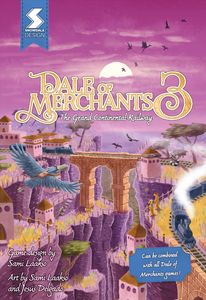
Designer: Sami Laakso
Artists: Jesús Delgado, Sami Laakso
Players: 2-4
Dale of Merchants 3 is the third (Editor: “What? Really? I would have thought it was the second”) game in the deckbuilding card game series where animalfolk inhabit the world and all of them have interesting abilities to affect the game state.
From my understanding, all three games (so far, there could be more coming…who knows?) basically give you more animal factions and new rules to cover their abilities.
It’s a very simple-sounding game that gets a bit more complex when you actually sit down at the table and try to set up combinations.

Each game (as I said, there are three!) comes with 6 different “animalfolk” decks, of which only some are used in the game depending on how many players there are (number of players plus one, so a 4-player game will have 5 different decks).
Each animalfolk deck will have its own theme and different powers. For example, red cards (the Sharing Short-Beaked Echidnas) like to let you swap cards with other players. The blue cards (Superstitious Snowshoe Hares) rely on the whims of chance (i.e. the blue die) to either benefit the player or not.
Players start with a 1-value card from each animalfolk deck and then a deck full of junk. No, literally. It’s called junk, but it can be used to buy other cards for your deck. It just has no extra power. The rest of the animalfolk cards are shuffled into one big deck (though any remaining 1-cost cards are removed from the game first).
During your turn, you can do one of four actions: Market (purchase a card from the market), Technique (use the “Technique” ability of one of the cards in your hand. If the card has a “plus” symbol on it, you can do another action), Stall (add a card to your Stall, which I will explain in a minute) or Inventory (discard cards from your hand).

The Market action will let you discard cards with enough value to pay for one of the cards in the Market. You’ll add that card to your hand.
Techniques are cards played for their ability.
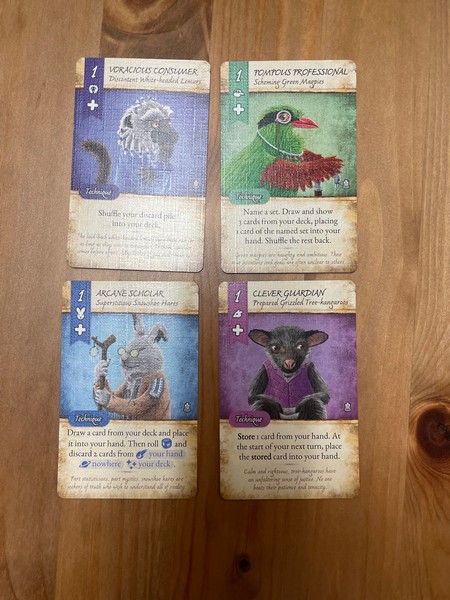
These usually let you do something and then the “Plus” sign in the top left corner under the card cost means you get to do another action. Clever Guardian, for example, lets you Store a card from your hand underneath it. At the start of your next turn, you get to put that card back into your hand.
The Stall action is the bread and butter of this game, because it’s how you win!
Players are essentially trying to set up a “Stall” of cards in front of them with increasing total values.
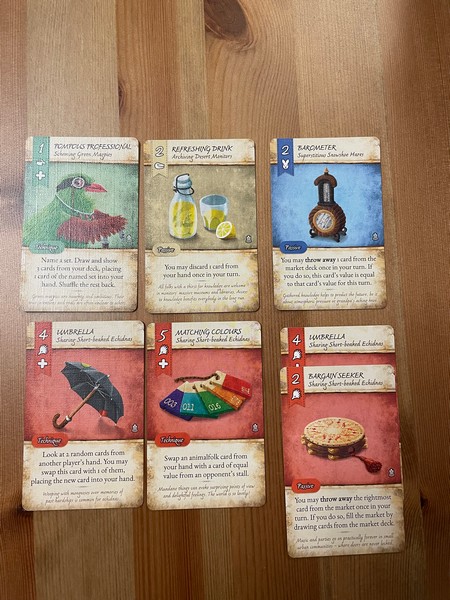
The first column is just value “1” so you use a “1” card from your hand. The next one is “2,” so you can either use two “1” cards (but only if you’ve managed to acquire another 1 card of the same animalfolk!) or one “2” card. The thing is, if you use multiple cards in the column, they must be the same colour/animalfolk.
Thus you are sacrificing having that card’s ability in your deck from now on.
As soon as a player has placed the “8” stall in front of them, the game ends.
Immediately.
None of this “oh, everybody gets the same number of turns” BS.
Nope. Immediately.
Gotta love a cutthroat game like that.
Another cool thing about the game compared to other deckbuilders is that discarding is actually a conscious action.
At the end of your turn, you fill your hand back up to 5 cards (which is why the Store action mentioned above is good, since you will start your next turn with 6 cards counting the Stored card).
However, you don’t discard. If you have two cards in your hand, then you only draw three new ones.
If you have 7 cards in your hand, you don’t draw any!
Yes, you have to make a conscious choice to essentially waste a turn and discard cards.
But sometimes that’s what you have to do.
I remember playing one of the early games of this and I wasn’t quite sure what to make of it. (It’s not in my BG Stats app but I know I played it)
Now that I have played this one twice, a part of me wants to get the whole enchilada and mix-n-match all of these different animalfolk to get different results.
It’s just a fun game!
You do have to be careful, however.
Don’t lose yourself in the card abilities, building your deck, looking at the gorgeous artwork.
That’s the way to get this quick little 20-40 minute game take up all of your lunch hour and you’re still not done.
The game is a race to have 8 Stall columns set in front of you.
No more, no less.
There are no style points. Just get ‘er done.
Our second game was finished within the allotted time.
I really do want to play this one again.
(Edit: 4/26/22) – Snowdale responded to my tweet about this post reminding me that I got the numbers wrong! See the Tweet below:
https://platform.twitter.com/widgets.jsDespite the name, Dale of Merchants 3, the series has 4 games so far. Dale of Merchants Collection is a big box that has a lot of new content and can be used to store the smaller games, 1, 2, and 3, inside. 😊 https://t.co/6MVyP30Xam
— Snowdale Design (@SnowdaleDesign) April 26, 2022
Santa Monica (2020 – Alderac Entertainment Group) – 1 play

Designer: Josh Wood
Artists: Jeremy Nguyen, Josh Wood
Players: 2-4
Santa Monica is a tableau-building game where players are drafting property cards that will allow them to build up the best beachfront area of Santa Monica that is possible.
Or at least better than everybody else’s.
It’s a fun game that can actually be finished inside of a lunch hour as long as players know the game a bit and you just have to shuffle the cards.

Players start with a Starting Feature tile that has both a beach area and a street area. Players will be trying to build up both the street and the beach to make it the most popular area for tourists as well as locals.
Then, on your turn, you will take one of the cards from the bottom row of the market.

If it’s a beach card, it will go on your top row, adjacent to something (even if it’s only to a street card below it). If it’s a street card, it will go on your bottom row with the same adjacency requirements.
As the game goes on, you’ll be building your own beachfront boardwalk and trying to score points by having the right attractions in the right place, as well as the right people in the right place.
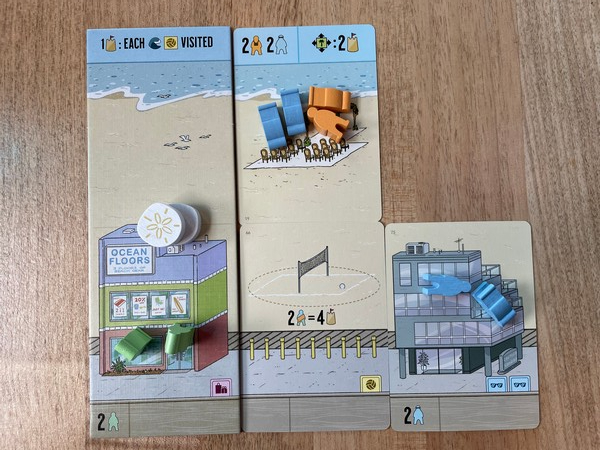
Some of the cards will give you people (either tourists or locals, as well as maybe VIPs, which are green).
Some cards will let you move people around while others will just give you people. You need to have people “assigned” to the circles on the various cards you place (like in the picture above, where two people of any colour, so either tourist or local, can play volleyball on the beach just off the boardwalk and get you 4 points).
If you have unassigned people at the end of the game, that’s bad because everybody needs to be doing something!

The green VIPs, as they move, will give you “footprint” markers that give you points depending on whether you send them walking through tiles that they want to visit. This is all shown on your starting tile, which says what cards will give you points for VIPs.
The game ends when somebody has placed their 14th “Feature” card (which is basically the cards you draft). The round continues until everybody has had a turn (wusses) and then you total up your points.
The trick with this game is that many cards will give you tags or circles to place people and other cards will give you victory points based on all of this stuff.

Here’s a finished tableau in our only game in March.
There are endgame scoring tiles which are chosen at the beginning of the game. Each one has some kind of negative effect for unplaced people, but they also give you points for doing certain things.
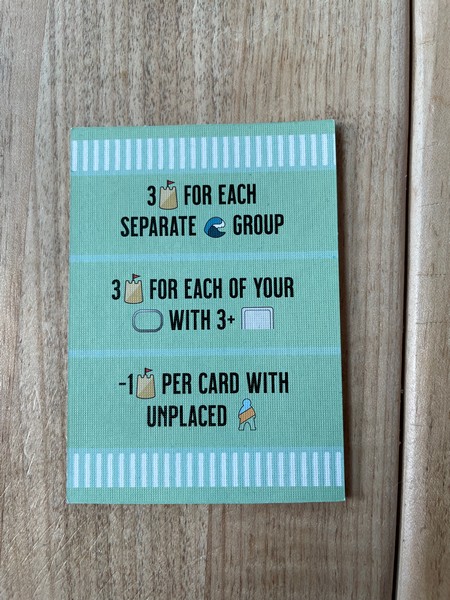
You can also earn Sand Dollars when you place feature cards, which will allow you to do a Sand Dollar action rather than just the “take a card” action.
These can break the rules somewhat (like maybe letting you take a card from the top row instead of the bottom).
There are other parts of the game, like the Food Truck and Foodie, which move along the market as you take cards and can give you bonuses, but I don’t want to make this description too complicated.
I have to say that I really liked this game, and I want to play it again. It seems like a perfect filler and lunch time game where you’re not spending a bunch of time but yet the decisions you have to make are pretty serious.
Yes, there are cards so there is some randomness, and I’m not sure how well it would work with 2 players if the Market of cards gets stagnant with cards neither player wants.
But our three-player game went really well and the scores were pretty close!
Once you get the hang of the game, it’s easily a lunch time game.
This one will be hitting the table again.
SCOUT (2019 – Oink Games) – 1 play

Designer: Kei Kajino
Artists: Rie Komatsuzaki, Jun Sasaki, sinc (小川)
Players: 2-5
I haven’t played too many games by Oink, but I know a number of my friends do like their games.
One of the Sundays in March, when we were stuck on one table and we had 5 players, a friend of mine brought out Scout by Oink Games.
It’s a neat little card game with some interesting things to keep in mind.

Ostensibly, you are trying to recruit for your circus, but really there isn’t a theme to this game.
Instead, you are dealt a hand of cards and you have to keep them in the same order as you received them. However, right at the beginning, you can flip your hand and use the other side if you wish. The cards helpfully show you what’s on the other side so you don’t have to spend too much brain power trying to figure out how it will look.

One player will lay out some cards. It could be one 7 or two 3s or whatever. Or it could be a run of 2+ cards like above.
The next player has to lay out something that will beat that. Sets will beat runs, so if somebody had a set of 1s, they could beat the player above. The cards that they beat will go into that player’s victory pile.
If you can’t beat it, then they will give that player a victory point token and take one of the end cards of that player’s set/run.

For example, if they couldn’t beat three 7s, they can then take one of the two end cards in that set and put it anywhere into their hand (the only time you can put a card into the middle of your hand). They can flip the card if they want before placing, but after they’ve placed it, it will remain that way forever.
That makes the cards on the table easier to beat for the other players.
Play continues until either one player plays their last cards or if somebody put down a set/run that is so powerful that nobody can beat it.
Either way, that’s the end of the round and players total up their points. They get negative points for cards in their hands (unless you were the one to play the unbeatable set, in which case you don’t get negatives) as well as victory points for “Scout” tokens (the tokens you get when somebody has to take your card) and cards in your victory pile.
It’s very possible to get a bunch of negative points in a round!

After a number of rounds equal to the number of players (so essentially each player gets to start a round), the game ends and you total all of your points. Whoever has the most is the winner!
This was a fun little filler game and it plays up to 5 players, which is awesome! It may wear out its welcome at 5 players, but it’s still playable in a pinch.
While it has the normal luck of any card game, it’s still a fun game where you have a lot of tactical decisions to make. It may be too luck-driven for some players, though. That being said, it’s a quick game, so why are you worried about it?
I’d definitely play this one again.
Fort (2020 – Leder Games) – 1 play
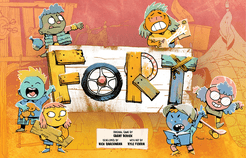
Designer: Grant Rodiek
Artist: Kyle Ferrin
Players: 2-4
Fort is a game that takes you back to your childhood and running around the neighbourhood with your friends.
Not that I had so many friends that I could make a game out of them!
But it was kind of neat to play outside and do outside things with them. Fort brings that back to life.
The objective in Fort is to do a couple of different things: either score 25 points to trigger the end game or build your Fort up to Level 5.
Both of these trigger the end, and then more points will be scored as appropriate.
(The game can also end if the Friends deck runs out, but I doubt that will happen often).

Players start with a player board (the cards in front of it aren’t there at the beginning…but I’ll get to that).
This board shows your Fort level (starting at level 0, of course) along with your Stuff (where you can keep pizza and toys) and your Pack (where you can keep extra of each, if you have room). It also has your Lookout, which will let you store some of your friends to, I guess, look out for the other players and make sure they don’t come and rain you (or something like that).

Each player starts with two “Best Friends” and 8 more Friends from the Friend deck in their own personal deck (yes, this is a deckbuilder of sorts).
You’ll have a hand of 5 cards. On your turn, you will play one of your cards and do at least one of its actions. The top action is a public action while the bottom one (with the person figure next to it) is a personal action. You must be able to do at least one of the actions to its fullest or you can’t play the card.
For example, the Thunder card above has a public action of copying your Pack (which means getting pizza and toys equal to what’s already in your Pack). It’s private action is to get one Pizza and add it to your Stuff.
If you don’t have room in your Stuff for one pizza (you can only hold 4 of each resource in your Stuff), then you can’t do the private action. If you don’t have room in your Stuff to copy your Pack, then you can’t do the public action. Thus, you can’t play that card.
Some actions will let you get pizza or toys equal to the number of the icon on your card (it could be the skateboard, glue, book, or a couple of others). You can play multiple cards of that suit to increase the amount of pizza/toys you can add to your Stuff.
Once you’ve completed your card, each other player can follow the public action on the card (even if you didn’t do it) by discarding a card of the same suit.
At that point, you have to recruit a card. You can recruit it from the Market, you can draw the top card of the Friend deck, or you can recruit from another player’s Yard.
Yes, that’s right.
Once you’ve done all of your actions, the rest of the cards in your hand (except Best Friends) go to your Yard. They will be available to other players for recruiting on their turn (you’re not playing with them, so maybe they’ll go to somebody else who will play with them). If it comes back to your turn and you still have Friends in your Yard, then those go to your discard pile.
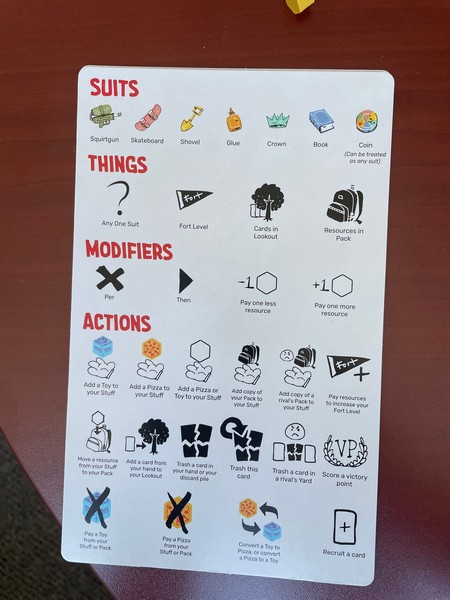
There is a great player aid with all of the actions and what they mean. It is so helpful, I can’t even begin to say it.
When you increase your Fort to its first level, you get to draw a “Made-Up Rule,” which basically gives you an endgame scoring card. There will be a number of cards available based on the number of players (players +1). You draw one of those randomly and that can guide you toward your future.

Once you increase your Fort to the second level, you get to choose a face-up Perk. Most of these are one-time use cards that let you break the rules, though some of them are just ongoing effects.

The Perks can have pretty good effects, though not all of them are as good as others.
Some card actions will be giving you points, and one of the game-end triggers is reaching 25 points. The scoreboard is pretty hand for this.
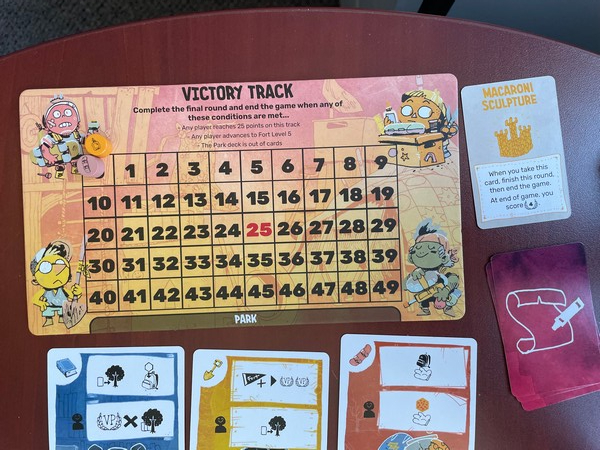
Once the game end has been triggered (the player who did that gets the 4-point Macaroni Sculpture) the current round is finished so each player has the same number of rounds (wusses!!!).
Then endgame scoring is done. Whoever has the most points is the winner!
One thing I didn’t mention is the Lookout, and that can be quite handy. When you place a card there, it is no longer in your deck. You won’t be able to play it for its abilities anymore.
However, its suit is available when you need it (so if you get 1 pizza per Skateboard you have played, any Skateboards in your Lookout count if you want them to, though this doesn’t apply if you’re following somebody else’s public action).
In addition, it’s not clogging up your deck but it counts as a card in your deck for endgame scoring. So if you get points based on how many Fort actions (for example), if a card in your Lookout has a Fort action, it counts!
I’ve only played this game twice so I need some more time with it, but it’s definitely a good game. It’s enjoyable and it’s reasonably quick.
Much like Dale of Merchants 3 above, though, you have to realize what the winning conditions are. It’s not good enough to build up your deck if you aren’t moving toward the endgame goals. You have to keep building your Fort up. Or you have to get a bunch of points from your cards.
Otherwise, it may not be a lunchtime game, and it really should be. It should be a 20-40 minutes game as it says on the box.
Once you get familiar with the rules and the nuances of how to play, though, it should go a lot faster.
The artwork (as shown above) is amazing as well. It just reeks of childhood! (because childhood can be pretty smelly)
Fort is another winner from Leder Games (publishers of Root) and I can’t wait to get this to the table some more.
So there you have it.
A bit late, but the new to me games I played in March.
What new to you games did you play in March?
Do you even remember because it’s been so long?
Let me know in the comments.
Great to see you back Dave!
LikeLiked by 1 person
Thanks, Michal! It’s good to be back.
LikeLiked by 1 person
In addition to there being four games in the Dale of Merchants series. Dale of Merchants Collection adds a lot more than just new animals! It adds player powers and some other really fun stuff.
Sounds like all winners this month, have you got a favourite? I really enjoy Fort and Dale of Merchants. Fort is great at different counts and feels pretty different as you get more cards to steal… err choose from.
LikeLiked by 1 person
Good to know that stuff about the DoM Collection. I wasn’t aware of that!
Of the four, I’d have to say Santa Monica at first blush, but I really liked Fort and I could see that taking first place as I play it more.
LikeLike
Pingback: SHUX 2022 Retrospective – Dude! Take Your Turn!